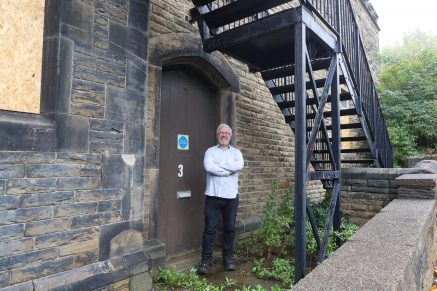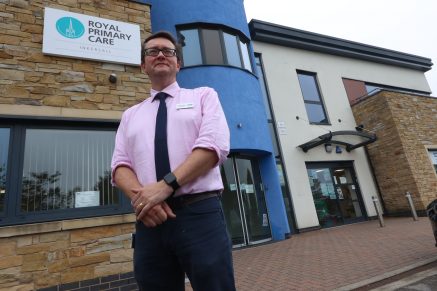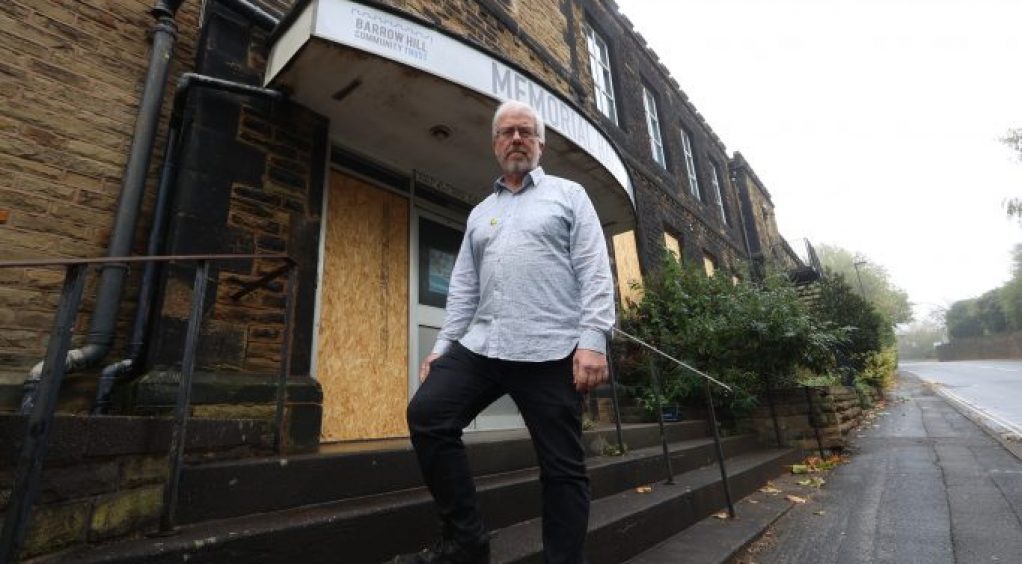Regeneration project is a trailblazer for tackling poor health
An innovative project is under way that will tackle some of the highest levels of health inequalities in Derbyshire.
NHS colleagues are working together with partners to ensure that good health and wellbeing is integral to the redevelopment of Barrow Hill Memorial Hall, near Staveley, Chesterfield.
Analysis shows that Staveley, and the 1,500 population of Barrow Hill estate in particular, has among the worst health outcomes in England.
Now NHS Derby and Derbyshire has agreed to fund the fitting out of a clinical consulting room and for healthcare professionals to provide services in the regenerated historic building – which has been a centre for health and wellbeing in the village since 1863.
Simon Redding, chair of the Barrow Hill Community Trust, pictured below at the planned entrance to the clinic.

The work is a key illustration of Joined Up Care Derbyshire’s approach as an integrated care system, to:
- tackle health inequalities and prevent ill health
- make investment decisions at “place” level, working with councils, the voluntary and community sector and with local communities
- use data and intelligence to guide decision-making
- support broader social and economic development
Local GP Dr Peter Scriven, Chesterfield local place alliance clinical lead, has worked with Derby University to analyse health and socio-economic data in the Chesterfield area.
This work has produced a series of maps at neighbourhood (known as “local super output area”) level that show a strong correlation between deprivation levels and conditions that risk ill health and early death.
Dr Scriven said: “The data shows that in the poorest areas there are relatively few people who live beyond 75 and that diseases caused by social factors dominate.
“People here live shorter lives and they suffer worse mental and physical health earlier in their lives than is the case elsewhere.”
Barrow Hill used to have a small branch GP service, but it was lost in 2015 and there is now no healthcare provision at all on the estate.
The community is relatively physically isolated from nearby Staveley and Chesterfield, which means local people who don’t have access to a car face long and difficult bus journeys to a GP surgery, or to a hospital clinic.
Dr Scriven said: “This project is really quite innovative because we will be doing things in a different way, in an area with a relatively small population but with very clear needs.
“It is a model of what we might do elsewhere. Targeted resources being deployed innovatively into a well defined natural community.
“It is a move away from the medical model of care to an approach that is about empowering people to make decisions that lead to good health and wellbeing – for example work, skills, social activity and exercise – while reducing the barriers to accessing medical care when it is needed.
“The NHS has a role. We will provide things like outreach clinics, screening, district nursing, identification of high blood pressure and diagnosis of conditions.
“But the solutions will be less medical and more based on social prescribing, lifestyle changes and community support. Primary care will have more of an oversight role.”
Dr Peter Scriven pictured below.

The Barrow Hill Memorial Hall refurbishment will create a new community hub where residents can access support services, and it will also provide a space for the community to socialise together.
The project is being funded through the Staveley Town Deal as part of the Government’s Levelling Up programme and has also received Heritage Lottery Funding.
It is planned to open in phases during 2024.
Simon Redding, chair of the Barrow Hill Community Trust pictured below inside the planned clinical room.

The building has been unused since 2016 but has a long history as a centre for good health and wellbeing in a community that has been scarred by the effects of heavy industry, poor quality housing and social housing allocation policy in the past that grouped the most deprived tenants together.
Simon Redding, chair of the Barrow Hill Community Trust, which is overseeing the building’s regeneration, said: “This place was built in 1863 for working men and has supported the health and wellbeing of local people for the past 150 years.
“It was given to the community after World War One when the health of the nation and the local workers here was shattered. It then helped the community to recover their mental health and wellbeing.
“More recently it has been used as a working men’s club, but that closed in 2016.”
The refurbished Memorial Hall is planned to replace and renew community activity that has been lost over recent years.
Simon added: “As services have pulled back they have become more difficult to access and at the same time as people’s health has got worse.
“We aim through this community centre to create a socially prosperous community, to bring people back together again and to address poor health through prevention.
“We will provide a café, community hub, warm hub, food bank, social prescribing on site. There will be space for indoor physical activities such as yoga.
“We will have local charities like Dementia UK, Age UK and Alzheimer’s UK. We will provide support for early years, a creche, a job centre, a skills training area.
“We are working with Derbyshire County Council to provide weight management support and help towards good mental health.
“This place will be an integrated service centre for local people that will provide the support people need to live as healthy a life as they can.”
Dr Penny Blackwell, GP at Hannage Brook Medical Centre, Wirksworth, chairs the “Derby and Derbyshire Integrated Place Executive” – which coordinates work between partners at local level to improve people’s health.
She said: “Projects like this are enabled now under our new integrated case system because of the strength of relationships at local level and the fact that all partners are committed to the same goals.
“The local NHS has an important role in helping people to achieve good health, but we can achieve so much more by working with the community and other service providers. This project is one example of many where we are changing our NHS approach so we can tackle health inequalities.”

